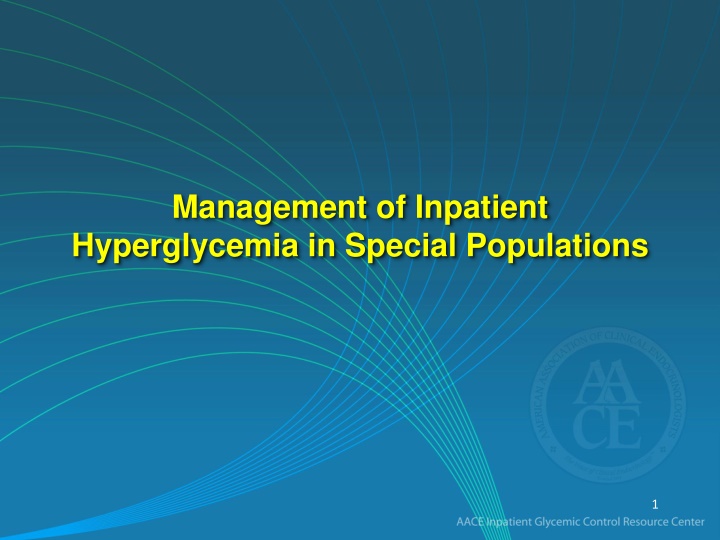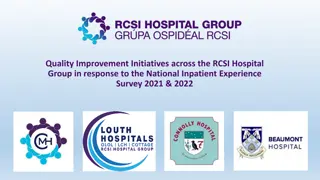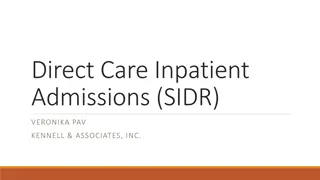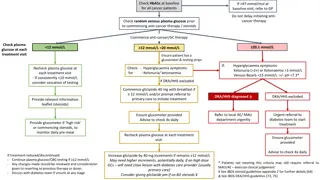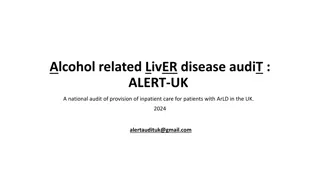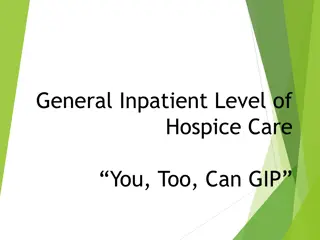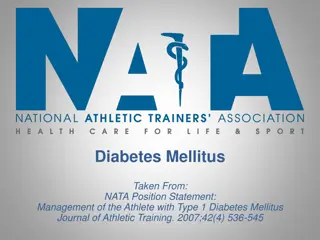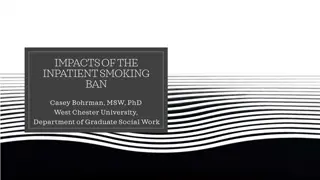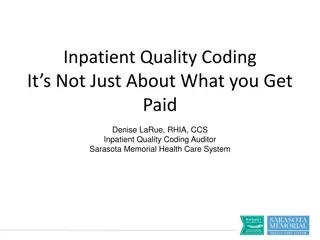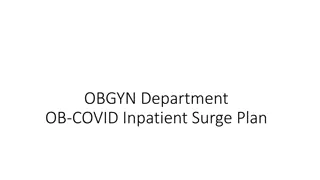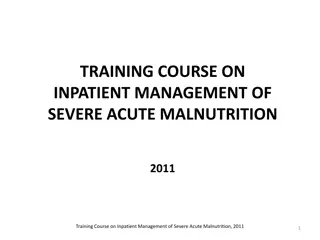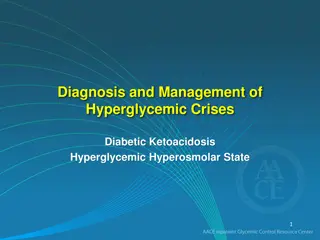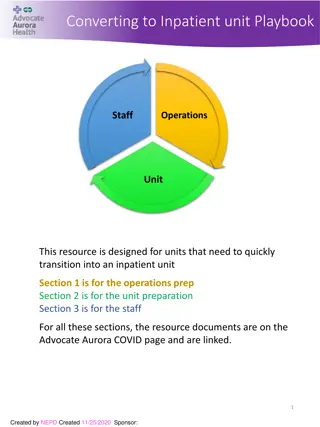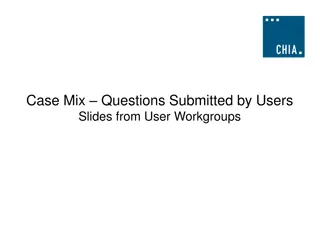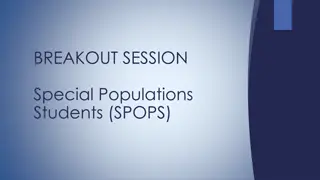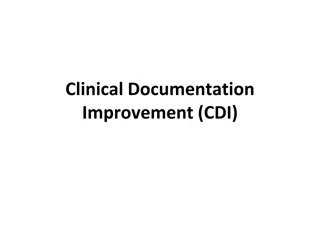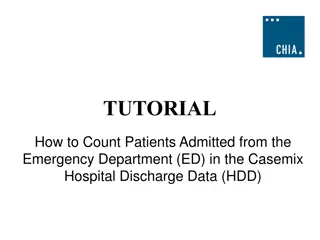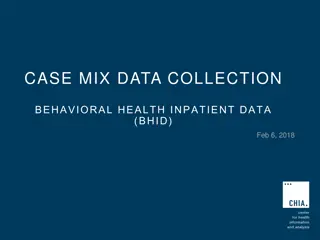Management of Inpatient Hyperglycemia in Special Populations: Overview
Inpatient hyperglycemia is associated with poor outcomes in various settings, impacting mortality risk, pneumonia risk, and other health risks. This article highlights significant findings and current recommendations for managing hyperglycemia in hospitalized patients, emphasizing the importance of tailored treatment approaches for different patient populations.
Download Presentation

Please find below an Image/Link to download the presentation.
The content on the website is provided AS IS for your information and personal use only. It may not be sold, licensed, or shared on other websites without obtaining consent from the author.If you encounter any issues during the download, it is possible that the publisher has removed the file from their server.
You are allowed to download the files provided on this website for personal or commercial use, subject to the condition that they are used lawfully. All files are the property of their respective owners.
The content on the website is provided AS IS for your information and personal use only. It may not be sold, licensed, or shared on other websites without obtaining consent from the author.
E N D
Presentation Transcript
Management of Inpatient Hyperglycemia in Special Populations 1
OVERVIEW 2
Inpatient Hyperglycemia and Poor Outcomes in Numerous Settings Study Patient Population Significant Hyperglycemia-Related Outcomes Mortality risk, pneumonia risk, ARF Pasquel et al, 2010 Total parenteral nutrition Mortality risk, surgery-specific risk Frisch et al, 2009 Noncardiac surgery Mortality risk; impaired prognosis Schlenk et al, 2009 Aneurysmal SAH All admitted patients, children s hospital ICU length of stay (LOS), ICU admissions Palacio et al, 2008 LOS, mortality risk, ventilator time, infection Bochicchio et al, 2007 Critically injured/trauma Chronic obstructive pulmonary disease LOS, mortality risk, adverse outcomes Baker et al, 2006 Community-acquired pneumonia LOS, mortality risk, complications McAlister et al, 2005 LOS, mortality risk, ICU admissions Home discharges All admitted patients (87% non-ICU) Umpierrez et al, 2002 Pasquel FJ, et al. Diabetes Care. 2010;33:739-741; Frisch A, et al. Diabetes. 2009;58(suppl 1):101-OR; Schlenk F, et al. Neurocrit Care. 2009;11:56-63; Palacio A, et al. J Hosp Med. 2008;3:212-217; Bochicchio GV, et al. J Trauma. 2007;63:1353-1358; Baker EH, et al. Thorax. 2006;61:284-289; McAlister FA, et al. Diabetes Care. 2005;28:810-815; Umpierrez GE, et al. J Clin Endocrinol Metab. 2002;87:978-982. 3
Current Recommendations for Hospitalized Patients All critically ill patients in intensive care unit settings Target BG: 140-180 mg/dL Intravenous insulin preferred Noncritically ill patients Premeal BG: <140 mg/dL Random BG: <180 mg/dL Scheduled subcutaneous insulin preferred Sliding-scale insulin discouraged Hypoglycemia Reassess the regimen if blood glucose level is <100 mg/dL Modify the regimen if blood glucose level is <70 mg/dL BG, blood glucose. Moghissi ES, et al. Endocrine Pract. 2009;15:353-369. Umpierrez GE, et al. J Clin Endocrinol Metab. 2012;97:16-38. 4
PATIENTS RECEIVING ENTERAL NUTRITION 5
Enteral and Parenteral Nutrition Provided to any patient who is malnourished or at risk for general malnutrition (ie, compromised nutrition intake in the context of duration/severity of disease) Parenteral Enteral For patients with or at risk for deranged GI absorption (intestinal obstruction, ileus, peritonitis, bowel ischemia, intractable vomiting, diarrhea) Short term: peripheral access (PPN) Long term: central access (TPN) For patients with intact gastrointestinal (GI) absorption Short term Nasogastric (NG) Nasoduodenal Nasojejunal Long term: (PEG) Gastrostomy Jejunostomy Ukleja A, et al. Nutr Clin Pract. 2010;25:403-414. 6
Synchronization of Nutrition Support and Metabolic Control Is Important Nutrition support: to achieve a calorie target Oral (standard and preferred) Enteral (gastrostomy, postpyloric, jejunostomy tubes) Parenteral (IV: peripheral, central) Metabolic control: to achieve a glycemic target Insulin Nutrition Support + Metabolic Control = Metabolic Support 7
Enteral Nutrition and Hyperglycemia Continuous or intermittent delivery of calorie-dense nutrients Wide variety of schedules and formulas Altered incretin physiology (?) Increased risk of hyperglycemia Basal insulin should be ideal treatment strategy, but Concerns about potential hypoglycemia after abrupt discontinuation (eg, gastric residuals, tube pulled, etc) Combined basal-regular strategies may be optimal 8
Enteral Nutrition: Is It Diabetogenic? Hyperglycemia Status 1-3 events* 27% 65% 4-6 events* 6% No hyperglycemia 2% 7 events* Patients in an acute care hospital on enteral feeding: mean age 76 years; 54.7% female; mean days EN 15 days. *Blood glucose >200 mg/dL. Pancorbo-Hidalgo PL, et al. J Clin Nurs. 2001;10:482-490. 9
Enteral Nutrition: Insulin Therapy Options 1. Basal (once or twice daily) + correction insulin 2. Basal + rapid acting every 6 hours + correction insulin 10
Variable Insulin Regimens Based on Different Types of Enteral Feeding Schedules Continuous EN Basal: 40%-50% of TDD as long- or intermediate-acting insulin given once or twice a day Short acting 50%-60% of TDD given every 6 h Cycled EN Intermediate-acting insulin given together with a rapid- or short-acting insulin with start of tube feed Rapid- or short-acting insulin administered every 4-6 hours for duration of EN administration Correction insulin given for BG above goal range Bolus enteral nutrition Rapid-acting analog or short-acting insulin given prior to each bolus BG, blood glucose; EN, enteral; TDD, total daily dose of insulin. 11
Insulin and Enteral Therapy: Coverage Protocol if Tube Feeds Abruptly Stopped 1. Calculate total carbohydrate calories being given as tube feeds 2. Assess BG every 1 h 3. If BG <100 mg/dL, give dextrose as D5W or D10W IV 4. Continue dextrose for duration of action of administered insulin Example Patient receiving 80 mL/h of Jevity Jevity = 240 mL/8 oz can, containing 36.5 g carb 1 mL Jevity 0.15 g (150 mg) carbohydrate @ 80 mL/h 12 g Give 120 mL/h D10W or 240 mL/h D5W 100 mL=5 g 100 mL=10 g enterally 12
PATIENTS RECEIVING PARENTERAL NUTRITION 13
Glycemia in Patients Receiving TPN Mean BG and mortality rate in hospitalized patients on TPN Pre-TPN 24 h TPN TPN days 2-10 50 276 patients receiving TPN 40 Mean BG Mortality (%) Pre TPN: 123 33 mg/dL 30 24 h TPN: 146 44 mg/dL TPN days 2-10: 147 40 mg/dL 20 10 <120 120-150 151-180 >180 0 Mean Blood Glucose (mg/dL) Pasquel FJ, et al. Diabetes Care. 2010; 33:739-741. 14
TPN, Glucose, and Patient Outcomes Study Cheung (2005) Lin (2007) Sarkisian (2009) Pasquel (2010) Hyperglycemia Definition (mg/dL) >164* >180** 180*** >180**** Mortality OR(95%CI) 10.90 (2.0-60.5)^ 5.0 7.22 2.80 (2.4-10.6)^ (1.08-48.3)^ (1.20-6.80)^ Any Infection OR(95%CI) 3.9 3.1 0.9 NA (1.2-12.0)^ (1.5-6.5)^ (0.3-2.5) Cardiac OR(95%CI) 6.2 1.6 1.3 NA (0.7-57.8) (0.3-7.2) (0.1-12.5) Acute Renal Failure OR(95%CI) 10.9 3.0 1.9 2.2 (1.2-98.1)^ (1.2-7.7)^ (0.4-8.6) (1.0-4.8) Septicemia OR(95%CI) 2.5 NA NA NA (0.7-9.3) Any Complication OR(95%CI) 4.3 5.5 NA NA (1.4-13.1)^ (2.5-12.4)^ ^ Significant at P<0.05. * ORs are expressed using blood glucose <124 mg/dL as a reference category. ** ORs are expressed using blood glucose <110 mg/dL as a reference category. *** ORs are expressed using blood glucose <180 mg/dL as a reference category. **** ORs are expressed using blood glucose <120 mg/dL as a reference category as measured within 24 h of PN initiation. Kumar PR, et al. Gastroenterol Res Pract. 2011;2011. doi:pii: 760720. 15
Parenteral Nutrition Continuous IV delivery of high concentrations of dextrose (20-25 gm/100 mL) No incretin stimulation of insulin secretion Hyperglycemia extremely common Basal insulin should be ideal treatment strategy, but... Concerns about potential hypoglycemia after abrupt discontinuation (eg, technical issues with line) 16
Parenteral Nutrition: Insulin Therapy Options 1. Basal (once or twice daily) + correction insulin 2. Basal + rapid acting every 6 hours + correction insulin
Should You Stop Insulin Infusion and Put Insulin in the TPN? Pros Cons Simplifies number of infusions/lines Easier if patient will be discharged on TPN Hard to predict insulin requirement Once it is in the bag, you cannot take it out
Frequency of Hyperglycemia in Patients Receiving High-Dose Steroids 1 BG >200 mg/dL 2 BG >200 mg/dL 90 81 75 64 56 60 52 Patients (%) 41 30 0 All No Hx DM Hx DM Donihi A, et al. Endocr Pract. 2006;12:358-262. 20
Steroid Therapy and Inpatient Glycemic Control Steroids are counterregulatory hormones Impair insulin action (induce insulin resistance) Appear to diminish insulin secretion Majority of patients receiving >2 days of glucocorticoid therapy at a dose equivalent to 40 mg/day of prednisone developed hyperglycemia No glucose monitoring was performed in 24% of patients receiving high-dose glucocorticoid therapy Donihi A, et al. Endocr Pract. 2006;12:358-362. 21
TES Guidelines for Glucose Control and Glucocorticoid Therapy The majority of patients (but not all) receiving high-dose glucocorticoid therapy will experience elevations in blood glucose, which are often marked Recommended approach Blood glucose monitoring for patients with or without diabetes receiving glucocorticoid therapy Patients without diabetes: may discontinue BG monitoring if BG remains <140 mg/dL without insulin therapy for 24-28 h Use continuous insulin infusion for patients with severe and persistent BG elevations despite use of scheduled basal-bolus SC insulin BG, blood glucose. Umpierrez GE, et al. J Clin Endocrinol Metab. 2012;97:16-38. 22
Steroid Therapy and Glycemic Control Patients With and Without Diabetes Patients without prior diabetes or hyperglycemia or those with diabetes controlled with oral agents Begin BG monitoring with low-dose correction insulin scale administered prior to meals Patients previously treated with insulin Increase total daily dose by 20% to 40% with start of high-dose steroid therapy Increase correction insulin by 1 step (low to moderate dose) Adjust insulin as needed to maintain glycemic control (with caution during steroid tapers) 23
PATIENTS TAKING U-500 INSULIN 24
U-500 Insulin When daily insulin requirements exceed 200 units/day Volume of U-100 injected insulin may be problematic Use of U-500 insulin (5 times more concentrated than U-100 insulin) may be appropriate but switching to U- 100 during hospital stay may prevent dosage errors Possible patients Obstetrics patients Patients receiving high-dose glucocorticoid therapy Patients with type 2 diabetes, obesity, or severe insulin resistance Kelly JL. Am J Health-Syst Pharm. 2010;67(suppl 8):S9-S16. 25
Use of U-500 vs U-100 in Hospital Setting Retrospective Analysis Hypoglycemia Hyperglycemia Severe hypoglycemia Severe hyperglycemia 100 80.6 78.9 80 Days (%) 60 * 40 * 16.8 15.3 20 6.3 2.8 1.3 0.1 0 Group A Group B U-500 for 50% of hospital stay (n=41) U-500 for <50% of hospital stay (n=20) Median BG, mg/dL 237.6 207.9 P=0.48 Median daily insulin dose 200 35 P<0.001 *P<0.001 vs Group B. BG, blood glucose. Tripathy PR, Lansang C. Endocr Pract. 2015:21:54-58. 26
Glycemic Control After Switching From U-500 to U-100 Retrospective Analysis TDD insulin as percentage of outpatient TDD 120 300 Blood glucose TDD Average daily glucose (mg/dL) 100 250 80 200 60 150 40 100 20 50 0 0 Outpatient Day 1 (n=62) Day 2 (n=49) Day 3 (n=35) Day 4 (n=29) Day 5 (n=19) TDD, total daily dose of insulin. Paulus AO, et al. Endocr Pract. 2016:22:1187-1191. 27
PATIENTS ON INSULIN PUMP THERAPY 28
Insulin Pump Therapy Electronic devices that deliver insulin through a SC catheter Basal rate (variable) + bolus delivery for meals Used predominately in type 1 diabetes Pumpers tend to be fastidious about their glycemic control Often reluctant to yield control of their diabetes to the inpatient medical team Hospital personnel typically unfamiliar with insulin pumps Hospitals do not stock infusion sets, batteries, etc, for insulin pumps (multiple models available from different manufacturers 29
The Challenge of Insulin Pump Use in the Hospital If patient is clinically stable, awake, alert, and able to independently manage his/her pump, continuation of pump therapy should be considered But many medical-legal issues! And many obstacles to safe pump therapy in the hospital (trained personnel, equipment, alarms, documentation, etc) Therefore, all hospitals should have a policy for the safe use of insulin pumps at their facilities 30
Insulin Pump Policy: Main Elements Patient qualifications for self-management (normal mental status, able to control device, etc) Pump in proper functioning order and supplies stocked by patient/family Signed patient contract/agreement Order set entry Documentation of doses delivered (pump flow sheet) Ongoing communication between patient and RN Policies regarding procedures, surgeries, CTs, MRIs, etc 31
AACE Position on CSII in the Hospital Patients who use CSII outside the hospital may use it inside if: Patient has the mental and physical capacity to use CSII for self- management Hospital personnel with CSII expertise are available Nurses document basal and bolus doses at least daily Specialist responsible for ambulatory CSII management should be contacted to make decisions about infusion rate adjustments A formal inpatient insulin pump protocol reduces confusion and treatment variability CSII, continuous subcutatneous insulin infusion. Grunberger G, et al. Endocr Pract. 2014;20:463-489. 32
Inpatient Insulin Pump Therapy: A Single Hospital Experience N=65 patients (125 hospitalizations) Mean age: 57 17 y Diabetes duration: 27 14 y Pump use: 6 5 y A1C: 7.3% 1.3% Length of stay: 4.7 6.3 days Pump therapy continued 66% Endocrine consults in 89% Consent agreements in 83% Pump order sets completed in 89% RN assessment of infusion site in 89% Bedside insulin pump flow sheets in only 55% Mean BG 175 mg/dL (same as off pump) No AEs (1 catheter kinking) Nassar AA, et al. J Diabetes Sci Technol. 2010;4:863-872. 33
A Validated Inpatient Insulin Pump Protocol Physician order set Consult diabetes service/endocrinologist Discontinue all previous insulin orders Check capillary blood glucose frequency Patient to self-administer insulin via pump Patient to document all BG and basal/bolus rates Insulin type order for pump: rapid-acting analog (lispro, aspart, glulisine) Set target BG range Implement hypoglycemia treatment protocol Noschese ML, et al. Endocr Pract. 2009;15:415-424. 34
A Validated Inpatient Insulin Pump Protocol Basal Insulin Rates Start Time Stop Time Basal Rate Units/h Start Time Stop Time Basal Rate Units/h Start Time Stop Time Basal Rate Units/h 12 am 1 am 0.7 8 am 9 am 1.0 4 pm 5 pm 0.7 1 am 2 am 0.7 9 am 10 am 1.0 5 pm 6pm 0.9 2 am 3 am 0.7 10 am 11 am 0.9 6pm 7 pm 0.9 3 am 4 am 0.7 11 am 12 pm 0.9 7 pm 8 pm 0.9 4 am 5 am 1.0 12 pm 1 pm 0.9 8 pm 9 pm 0.9 5 am 6 am 1.0 1 pm 2 pm 0.9 9 pm 10 pm 0.9 6 am 7 am 1.0 2 pm 3 pm 0.9 10 pm 11 pm 0.7 7 am 8 am 1.0 3 pm 4 pm 0.7 11 pm 12 am 0.7 Patient to self-administer insulin via SC insulin pump and document all basal rates Noschese ML, et al. Endocr Pract. 2009;15:415-424. 35
A Validated Inpatient Insulin Pump Protocol Meal boluses based on: Carbohydrate count Fixed doses Breakfast ___ u/per _____gram ___ u at Breakfast or Lunch ___ u/per _____gram ___ u at Lunch Supper ___ u/per _____gram ___ u at Supper Snacks ___ u/per _____gram ___ u with Snacks Correction boluses: _____ unit(s) for every ____mg/dL over ____ mg/dL (target glucose) Noschese ML, et al. Endocr Pract. 2009;15:415-424. 36
A Validated Inpatient Insulin Pump Protocol Hospitalizations After Implementation of an Inpatient Insulin Pump Protocol (IIPP) Mean BG (mg/dL) P value Group 1 - IIPP+DM consult (n=34) 173 43 Group 2 - IIPP alone (n=12) 187 62 NS Group 3 - Usual care (n=4) 218 46 More inpatient days with BG >300 mg/dL in Group 3 (P<0.02.) No differences in inpatient days with BG <70 mg/dL 1 pump malfunction; 1 infusion site problem; no SAEs 86% of pumpers expressed satisfaction with ability to manage DM in the hospital Noschese ML, et al. Endocr Pract. 2009;15:415-424. 37
Clinical Outcomes with Inpatient CSII Systematic Review (N=11 Studies*; 624 Patients) Inpatient mortality None reported (only 1 study assessed mortality in 253 patients over 1000 patient-days) Hyperglycemia Trend toward less hyperglycemia with CSII Hypoglycemia Trend toward more hypoglycemia with CSII Length of stay Shorter stay with continued CSII (4.5 days) vs suspended CSII or IV infusion (7 days) Average blood glucose CSII continued: 175 mg/dL; suspended CSII or IV infusion: 178 mg/dL *9 retrospective; 2 prospective, including 1 randomized, controlled study. CSII, continuous subcutaneous insulin infusion; IV, intravenous. Anstey J, et al. Diabet Med. 2015;32:1278-1288. 38
Efficacy of CSII in Hospitalized Patients with Type 2 Diabetes No significant differences between treatment groups in Mean daily CBG levels Percent of preprandial CBG values in the target range Daily standard deviation of BG on day 5 Insulin dose lower in CSII group (P<0.05) Hypoglycemia CSII: 0.06 events/patient per day IV insulin: 0.015 events/patient per day Between group difference not statistically significant No severe hypoglycemia reported in either group Fasting Plasma Glucose CSII with lispro (n=20) IV regular insulin (n=13) 250 201 194 200 FPG (mg/dL) * * 150 126 118 100 50 0 Day 1 Day 5 *P<0.05 vs day 1. BG, blood glucose; CBG, capillary blood glucose; CSII, continuous subcutaneous insulin infusion; IV, intravenous. Boullu-Sanchis S, et al. Diabetes Metab. 2006;32:350-357. 39
Results of an Inpatient CSII Protocol IDS + IPP IPP No IDS/IPP N (% female) 34 (32) 12 (50) 4 (75) 48 15 51 16 36 12 Age 9.8 15.4 5.2 6.2 3 1.5 LOS (days) 5.4 7.1 3.2 2.9 3 1.5 CSII use (days) 173 43 187 62 218 46 Mean CBG (mg/dL) Patient days with 1 CBG <70 21 10 20 All CBG 70-180 25 24 24 1 CBG 181-300 56 55 73 1 CBG >300 22 7 60 IDS, inpatient diabetes service; IPP, inpatient pump protocol. Noschese ML, et al. Endocr Pract. 2009;15:415-424. 40
Inpatient CSII Therapy in Patients Treated With Insulin as Outpatients Patients completing questionnaire (n=17) reported a high degree of satisfaction with their ability to continue CSII therapy in the hospital There were 2 CSII related adverse events 1 infusion site problem 1 pump malfunction Noschese ML, et al. Endocr Pract. 2009;15:415-424. 41
Inpatient CSII Therapy Prevalence of hyperglycemia and hypoglycemia in inpatients who continued (pump on) or discontinued (pump off) CSII during their hospital stay Bailon RM, et al. Endocr Pract. 2009;15:24-29. 42
Hyperglycemic Events in Patients Continuing or Stopping CSII Therapy During Their Hospital Stays Pump On Pump Off Values per person Blood glucose (mg/dL) Bailon RM, et al. Endocr Pract. 2009;15:24-29. 43
Hypoglycemic Events in Patients Continuing or Stopping CSII Therapy During Their Hospital Stays Pump On Pump Off Blood glucose (mg/dL) Bailon RM, et al. Endocr Pract. 2009;15:24-29. 44
Blood Glucose Levels with Peri-operative CSII Patients with Diabetes Undergoing Same-Day Surgery (N=49) Post-op CBG 200 mg/dL Mean Post-op CBG 100 250 217.8 205.7 194.8 80 181 200 175.6 173.8 68.8 Blood glucose 62.8 Patients (%) 57.4 60 (mg/dL) 150 50 42.8 33.3 40 100 20 50 0 0 T1D T2D All diabetes T1D T2D All diabetes CSII Usual care CSII Usual care CBG, capillary blood glucose; CSII, continuous subcutatneous insulin infusion. Sobel SI, et al. Endocr Pract. 2015;21:1269-1276. 45
Inpatient Management of Hyperglycemia: Managing Safety Concerns Both undertreatment and overtreatment of hyperglycemia create safety concerns Areas of risk Changes in carbohydrate or food intake Changes in clinical status or medications Failure to adjust therapy based on BG patterns Prolonged use of SSI as monotherapy Poor coordination of BG testing with insulin administration and meal delivery Poor communication during patient transfers Errors in order writing and transcription 46
PERIOPERATIVE RECOMMENDATIONS 47
Pre-Op Recommendations for Patients Admitted Day of Surgery: Patients on Noninsulin Agents Withhold noninsulin agents the morning of surgery Insulin is necessary to control glucose in patients with BG >180 mg/dL during surgery Noninsulin agents can be resumed postoperatively when: Patient is reliably taking PO Risk of liver, kidney, and heart failure are lower 48
Pre-op Recommendations for Insulin Treated Patients Morning of surgery Give 50-75% of home basal insulin dose (NPH/glargine/detemir) Do NOT give prandial insulin Give correction for hyperglycemia For prolonged procedures initiate insulin infusion
Pre-op Recommendations: Patients Using Insulin Pump Discontinue insulin pump and change to IV insulin according to patient s current basal rate If basal rate <1 unit/h, start IV insulin at 0.5 units/h If basal rate 1-2 units/h, start IV insulin at 1 units/h Monitor BG hourly, with titration per insulin infusion protocol For brief surgical procedures in which the pump insertion site is not in surgical field, may consider continuing pump therapy Reduce basal rate by 20% (eg, 1 u/h changes to 0.8 u/h) Remove pump and initiate insulin infusion if patient becomes hemodynamically unstable Hypoglycemia and hyperglycemia treated in manner similar to that of patients receiving SC insulin pre-op 50
